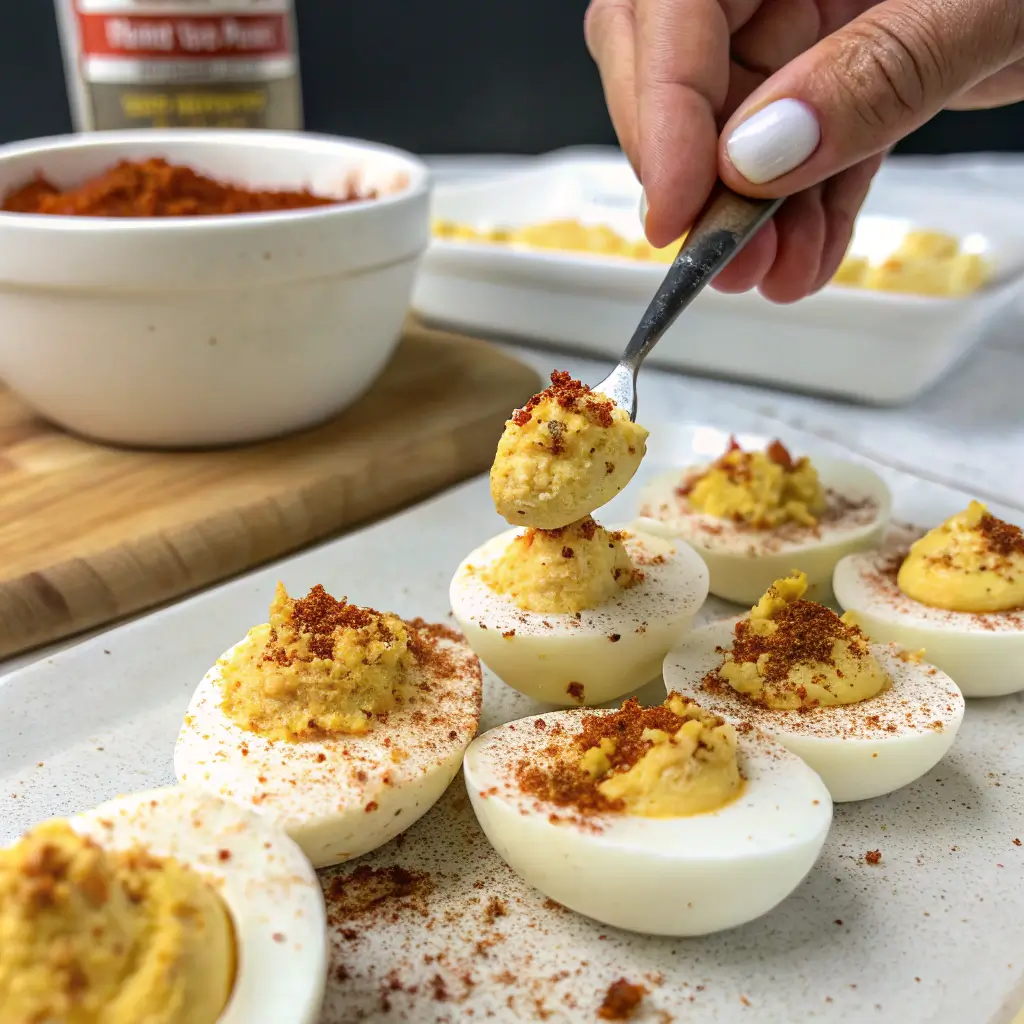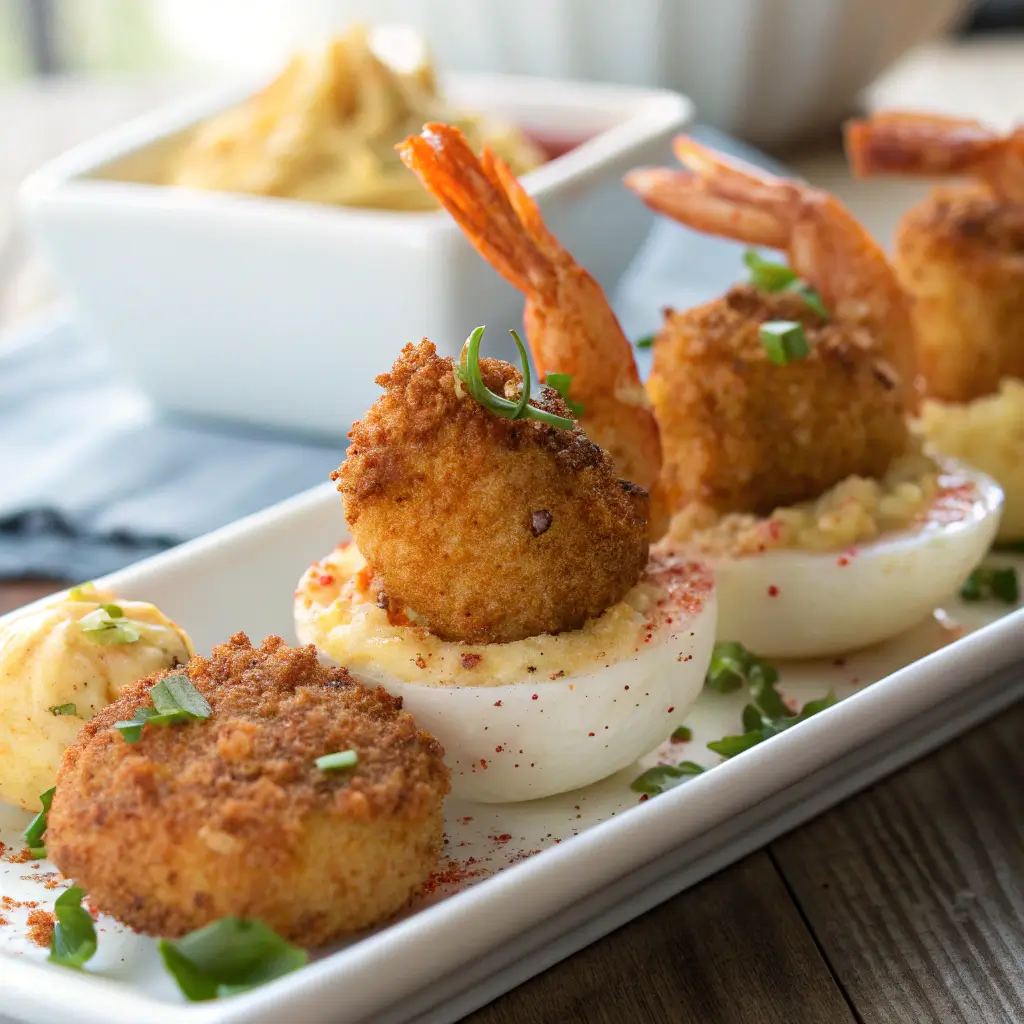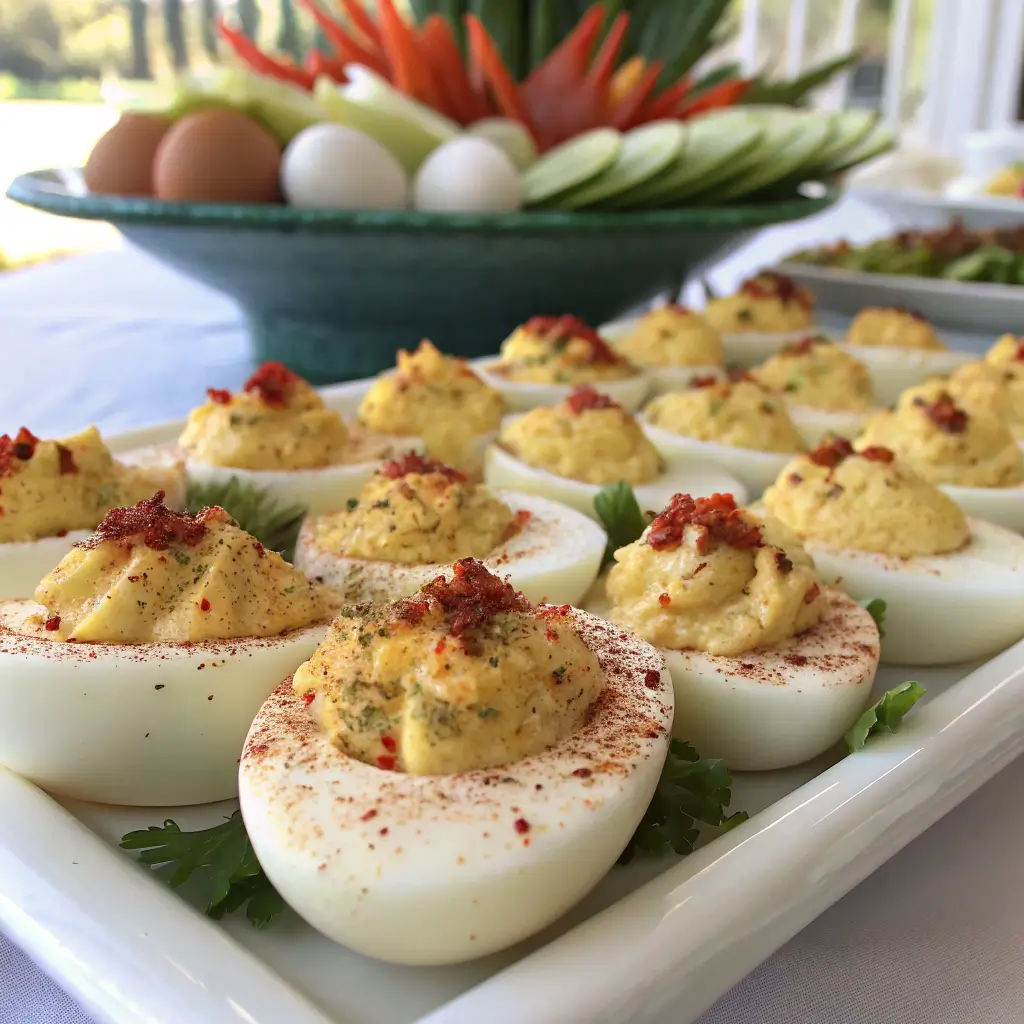Deviled eggs are a beloved appetizer that never goes out of style, but what happens when you spice things up with bold, zesty Cajun flavors? This article dives into the world of Cajun deviled eggs, exploring their origins, unique ingredients, and how they bring a twist to a classic dish. From step-by-step preparation to creative variations, serving tips, and even FAQs, you’ll find everything you need to create a show-stopping snack that’s perfect for any occasion.
Table of Contents
Cajun Deviled Eggs
The Origin of Deviled Eggs
Deviled eggs have been gracing tables for centuries, with origins tracing back to ancient Rome, where hard-boiled eggs were seasoned with spicy sauces. Over time, the recipe evolved, with the term “deviled” becoming synonymous with spicy or zesty flavors. Today, these little bites are a staple at gatherings, offering endless opportunities for customization.
Introduction to Cajun Cuisine
Cajun cuisine hails from Louisiana, rooted in the culinary traditions of French-speaking Acadian immigrants. Known for its bold, spicy flavors, Cajun cooking uses a mix of paprika, cayenne, garlic powder, and other seasonings to create unforgettable dishes. Combining simple ingredients with a hearty dose of spice, it’s no wonder Cajun food has gained global popularity.
Fusion of Traditions: Cajun Deviled Eggs
When the classic deviled egg meets the vibrant world of Cajun spices, magic happens! By infusing a creamy yolk mixture with zesty Cajun seasoning, a touch of hot sauce, and flavorful garnishes like bell peppers or shrimp, you get a dish that’s as visually striking as it is delicious. Whether you’re hosting a party, heading to a picnic, or just indulging at home, Cajun deviled eggs bring a unique twist that’s sure to impress.
Essential Ingredients for Cajun Deviled Eggs
Key Components of Traditional Deviled Eggs
The foundation of any good deviled egg starts with a few simple ingredients. Hard-boiled eggs, mayonnaise, mustard, and a pinch of salt create the creamy filling that people love. The egg whites act as the perfect vessel for holding that luscious, savory mixture. These ingredients form the base, but the magic lies in how you season them!
Incorporating Cajun Spices and Seasonings
To transform traditional deviled eggs into Cajun deviled eggs, you’ll need to amp up the flavor with bold seasonings. A blend of paprika, cayenne pepper, garlic powder, and onion powder gives the filling its signature kick. Adding a splash of hot sauce and a hint of Worcestershire sauce deepens the flavor, while a squeeze of fresh lemon juice brightens it up. Don’t forget a pinch of salt to bring everything together. For added texture, consider mixing in finely chopped celery or green onions.
Optional Additions: Celery, Bell Pepper, and Onions
Want to take your Cajun deviled eggs to the next level? Toss in some diced bell peppers or onions for a slight crunch and extra sweetness. These ingredients not only enhance the taste but also add a pop of color, making the dish as visually appealing as it is delicious. A sprinkle of freshly chopped parsley or a few crumbles of crispy bacon on top will elevate the presentation even further.
Step-by-Step Preparation Guide

Boiling and Preparing the Eggs
Start by boiling your eggs to perfection. Place them in a pot, cover with cold water, and bring to a gentle boil. Once boiling, let them simmer for about 10–12 minutes. Immediately transfer the eggs to an ice bath to stop the cooking process and make peeling easier. When cool, peel the eggs carefully to avoid damaging the whites.
Creating the Cajun-Inspired Filling
Slice each egg in half lengthwise and gently scoop out the yolks. In a mixing bowl, mash the yolks with a fork until smooth. Add mayonnaise, mustard, and your Cajun seasoning mix. Adjust the level of spice to your preference—add a dash of hot sauce for more heat or keep it mild for sensitive palates. Mix until creamy and fully combined. For extra flavor, fold in optional ingredients like diced celery, bell peppers, or even finely chopped pickles.
Assembling and Garnishing the Deviled Eggs
Using a spoon or a piping bag, fill each egg white half with the creamy Cajun mixture. Be generous—each bite should be packed with flavor. To finish, garnish the eggs with a sprinkle of paprika, a few slices of green onion, or even a small shrimp for a touch of elegance. Arrange them on a platter, and they’re ready to serve!
With these steps, your Cajun deviled eggs will be bursting with flavor and perfectly suited for any occasion!
Variations and Creative Twists

Cajun Shrimp Deviled Eggs
Looking to elevate your Cajun deviled eggs? Adding shrimp brings a delightful seafood twist. Begin by preparing the classic Cajun filling as previously described. Then, sauté small shrimp with a sprinkle of Cajun seasoning until cooked through. Once cooled, place one shrimp atop each filled egg half. This addition not only enhances the flavor but also adds an elegant touch to your appetizer spread.
Deep-Fried Cajun Deviled Eggs
For a crunchy variation, consider deep-frying your Cajun deviled eggs. Start by preparing the eggs as usual, but before filling them, coat the egg white halves in flour, dip them in beaten egg, and then dredge in breadcrumbs seasoned with Cajun spices. Fry until golden brown and crispy. Once cooled slightly, pipe in the Cajun-spiced yolk mixture. The result is a tantalizing contrast between the crispy exterior and the creamy, spicy filling.
Vegetarian Alternatives
If you’re catering to vegetarians or simply seeking a meat-free option, there are plenty of ways to get creative. Incorporate finely chopped roasted red peppers or sun-dried tomatoes into the filling for added depth of flavor. Alternatively, mix in some diced jalapeños for an extra kick. These variations maintain the essence of Cajun deviled eggs while accommodating different dietary preferences.
For more delicious recipes, check out our Festive Twists on Classic Christmas Deviled Eggs.
Serving Suggestions and Pairings
Ideal Occasions for Cajun Deviled Eggs
Cajun deviled eggs are versatile appetizers suitable for various events. Whether it’s a casual family gathering, a festive holiday party, or a summer picnic, these spicy bites are sure to be a hit. Their bold flavors make them stand out, ensuring they won’t be just another dish on the table.
Complementary Dishes and Beverages
To create a harmonious menu, pair your Cajun deviled eggs with dishes that balance their spiciness. A fresh green salad with a tangy vinaigrette, creamy coleslaw, or even a mild potato salad can complement the heat. For beverages, consider serving a crisp white wine, light beer, or a refreshing iced tea to cleanse the palate between bites.
Presentation Tips for Entertaining
Presentation plays a crucial role in the appeal of your Cajun deviled eggs. Arrange them on a platter lined with leafy greens for a pop of color. Garnish each egg with a sprinkle of paprika, a slice of green onion, or a small piece of roasted red pepper to hint at the flavors within. Using a piping bag for the filling adds a professional touch, making your appetizers as visually enticing as they are delicious.
By exploring these variations and serving suggestions, you can tailor your Cajun deviled eggs to suit any occasion, ensuring they remain a memorable part of your culinary repertoire.
Frequently Asked Questions (FAQs)
What are the five golden rules of deviled eggs?
- Use Fresh, Quality Eggs: Fresh eggs ensure the best taste and texture, while slightly older eggs are easier to peel after boiling.
- Cook Eggs Perfectly: Avoid overcooking to prevent a gray-green ring around the yolk. Boil gently and cool immediately in an ice bath.
- Mash the Yolks Smoothly: For a creamy filling, mash yolks thoroughly with a fork or use a food processor for a lump-free texture.
- Balance the Flavors: Blend creamy elements (like mayo) with tangy ones (mustard or vinegar) and season generously. Adjust to taste.
- Garnish Thoughtfully: Use paprika, herbs, or other toppings to add visual appeal and a flavor boost. Presentation matters!
What is the difference between angel eggs and deviled eggs?
The difference lies in the filling ingredients. Angel eggs are a lighter, healthier version of deviled eggs. Instead of mayo and mustard, they often use alternatives like Greek yogurt, hummus, or avocado. The term “angel” is also used to give a more positive or wholesome connotation compared to “deviled.”
What’s the trick for deviled eggs?
The secret to great deviled eggs lies in three key techniques:
- Perfectly Boiled Eggs: An ice bath stops cooking instantly, making eggs easier to peel and whites smooth.
- Piping the Filling: Using a piping bag or a zip-top bag with a corner cut off ensures clean, attractive presentation.
- Balancing the Filling: Adding a touch of acidity (like vinegar or lemon juice) and seasoning well creates depth of flavor.
What do Catholics call deviled eggs?
Some Catholics and other religious communities prefer to avoid the term “deviled” due to its connotations. Instead, they use alternative names like angel eggs, stuffed eggs, or dressed eggs. These names retain the dish’s charm while aligning with a positive tone.
Conclusion
Cajun deviled eggs are a delightful twist on a classic appetizer, blending the creamy richness of traditional deviled eggs with the bold, spicy flavors of Cajun cuisine. Whether you’re serving them at a casual picnic, a festive party, or as part of a holiday spread, these eggs are guaranteed to impress. From shrimp-topped variations to deep-fried delights, the possibilities are endless. So, grab your favorite Cajun spices, get creative in the kitchen, and let these flavorful bites steal the show. For more recipe inspiration, explore our website and discover new ways to add zest to your meals!

